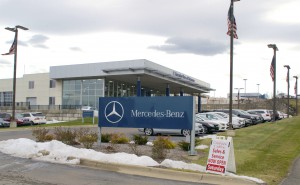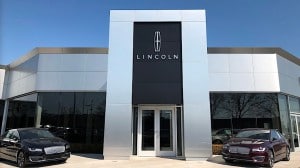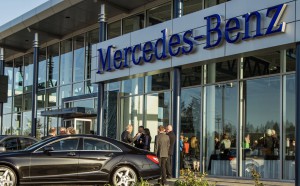New car sales were down by about 48% last week as the coronavirus pandemic continued to take its toll – but that actually was the good news, according to J.D. Power analysts whose earlier forecasts predicted U.S. demand was likely to tumble by as much as 80% for all of April.
While there are numerous uncertainties yet to play out, starting with what happens as states begin lifting lockdown orders and automakers begin ramping up production again, but there are clear signs that the car market may now be past the worst.
“After many weeks of the market turning downward,” said Power Analyst Tyson Jominy, “what we’re seeing is a flattening (of the downturn) and indications the retail market is in recovery.”
(European auto sales fell more than 50% in March.)
How long that recovery will take is far from certain, cautioned Jominy and other Power analysts who joined him Wednesday afternoon in a media call. What remains clear, they said, is that it will still be months before new vehicle sales come back to levels that had been anticipated before the pandemic.
Just through July, the industry is still expected to lose as much as 1.8 million sales compared to what Power and other analysts originally had forecast — 2020 expected to see a modest dip, to around 16.8 million vehicles compared to last year’s sales of 17.1 million new cars, trucks and crossovers.
In a statement, Power revised its official forecast for 2020 sharply downward, saying, “The 2020 full-year outlook for total sales is now 12.6 to 14.5 million.” At the low end, that would be the sort of number last seen during the depths of the Great Recession a decade ago.
Power has been closely following automotive sales trends using its PIN network which accesses real-time sales data from thousands of dealers across the country. During an hour-long webinar, the research firm noted that 24 of the top 25 U.S. regional markets showed improvements during the week ending April 19, but there were significant differences from one region to another.
In Detroit, where sales came to a virtual stop last month as it became clear the city was experiencing one of America’s worst COVID-19 outbreaks, sales showed some “resilience” last week, according to Jominy, though they were still off 85% from what was expected pre-pandemic.
Dallas, on the other hand “performed very soundly,” he added, with sales off a much more modest
20% for the week.
The rebound also varied widely depending on product segment. Luxury sales remained down by more than half – in part reflecting the slow return to the market by lease customers. Compact car sales were off by 60%. As has been the case for the past month, demand for pickups all but defied the overall industry downturn, lagging just 16% behind original, pre-pandemic forecasts.
(U.S. car sales tumble sharply — but not as bad as originally feared.)
Last week’s upturn was clearly helped by the fact that dealers in all 50 states are now authorized to sell vehicles again – 24 in showrooms, the other 26 online.
The rebound also reflected the money that manufacturers are using to lure in buyers. On average, new vehicles carried $4,700 in incentives, off a mere $100 from the week before. On some products, such as pickups, the givebacks topped $7,000. Tellingly, nearly one in four buyers opted for the 84-month, zero-interest loans that are becoming commonplace.

A new J.D. Power/LMC Automotive forecast shows that global auto sales will remain significantly depressed for all of April.
Detroit automakers were quick to go with high-value givebacks, particularly on their high-profit pickups, something that has helped them regain market share at levels not seen in a decade.
If anything, look for the deals to get even more lucrative, particularly from foreign-owned brands, said Power’s Chief Data Officer Thomas King. “We’re starting to see manufacturers be a bit more aggressive,” he added, “to make sure they have offers compelling to buyers coming back to market.”
The hefty incentives on new vehicles may actually pose problems on the other side of the car market, said Jonathan Banks, vice president of vehicle valuations and analytics at J.D. Power Valuation Services. For many traditional used car customers, the deals may lure them to switch to something new.
At the same time, “the better the deal on the new, the more the prices on used vehicles are depressed,” creating challenges for used car dealers, said Banks, forecasting that previously owned vehicles could see prices tumble by anywhere from 8 to 16% in the coming months.
Ironically, the pandemic could work in the favor of both new and used car dealers, Banks suggested. Even as the country prepares to come out of lockdown, studies show the majority of Americans are worried about future outbreaks. As a result, predicted Banks, “Consumers are going to migrate away from shared riding and mass transportation” towards using their own vehicles. And for those who don’t now have a family car they may now choose to buy one.
(Post-pandemic, global auto sales still likely to remain tanked through 2021.)
The course of the coronavirus has been difficult to predict, as has its effects. The coming weeks, as more and more states lift shelter-in-place and business closure orders, could yet bring some surprises. That includes the possibility of new and renewed outbreaks which could toss all forecasts into the wind.




New cars have to drop 50% in price before they have felt the full effect of the virus. My guess is the US gov will have a large “Cars for Clunkers” to sucker new buyers in to get into debt on over priced junk.
With high unemployed and working from home, if employed… Why would consumers want to load up in debt and to pile their driveways?
Low prices + Low interest